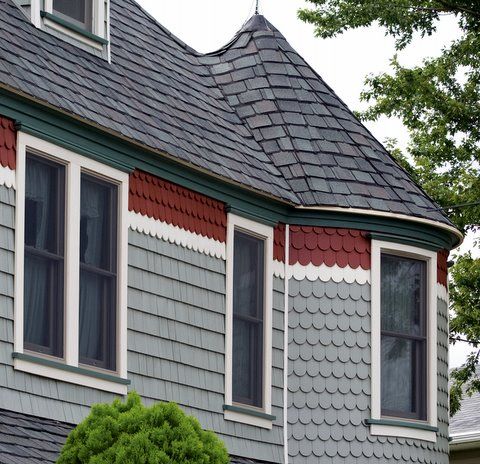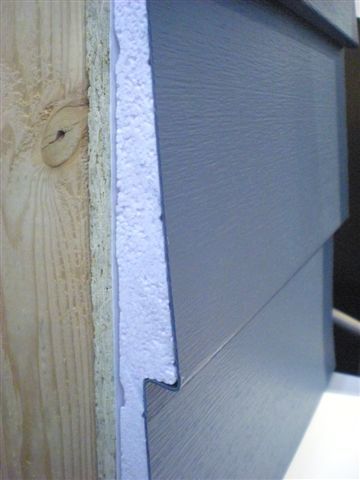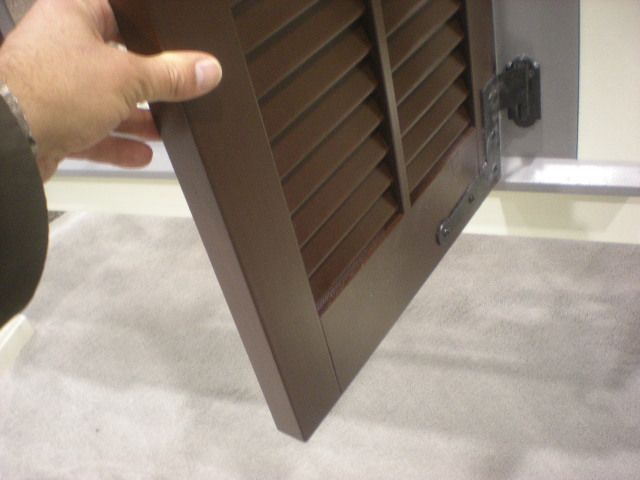
With building material development lagging during these recessionary years, my focus during IBS has turned away from scouring the show floor for the newest products, toward rediscovering old products. In other words, lacking the new, searching for the improved. In this vein, I was surprised by the sophisticated design focus exhibited by vinyl siding manufacturers. Instead of drab display walls of mismatched, pastel-colored siding with a token window and shutters punched in for effect, the booths at this year’s exhibit featured whole house displays that resembled high design studios with New Urbanism sensibility. The design boards hawking new colors and lap profiles were assembled by historical architects with a delicate sensitivity to color combinations and matching accessories, illustrating a renewed sensitivity toward esthetics and quality in an industry trying to free itself of associations with being, well, cheap and ugly. Perception and reality the industry is trying hard to change.
To be fair, today’s vinyl siding is not the same as the limited, low-quality offering of twenty years ago. Advancing manufacturing process and industry-wide quality control regulation has improved the product as much as Ford Motor Company has made good on its slogan, “Have you driven a Ford, lately?”
Color Choices: To start, vinyl now offers more than 400 ASTM certified colors. Colors tested by an independent, ASTM approved agency to guard against premature fading. The pallet includes a broad array of popular deep colors, such as dark greens, plumb, and burgundy. Less successful, translucent imitations of stained wood. Most surprising, manufacturers, such as PlyGEM™, now offer custom color matching. You send in a swatch, they will match the color exactly in your preferred siding profile using the same spectral analysis technology available at the paint store. How’s that for limited color choices?
Energy Efficiency: On the energy front, vinyl now offers EnergyStar® claddings, solar reflective colors with integrated insulation. Insulated vinyl siding offers an average R-3, nothing dramatic, but it can help you meet or exceed code requirements in certain wall assemblies. The advantage of insulated vinyl siding, according to the industry representatives I spoke with, also comes with greater impact, and wind resistance, as well as a more realistic lap profile (see photo #2).
Green Credentials: If you are one of those that belive vinyl has no place in a green building portfolio, consider that it is accepted by all the major green building certifications, including LEED for Homes, and can garner more points than almost any other cladding.
Lifecycle analysis is the key, from manufacture through lifespan and disposal vinyl has a tested and verifiably lean carbon footprint by magnitudes in comparison to masonry or stucco. A comparison to fiber cement siding is not possible; the genre has not undergone life-cycle analysis, despite claims to green-credibility.
Just as vinyl siding has improved as a product, the manufacturing process has, too. No longer spewing large doses of dioxin, manufacturers recycle almost 100-percent of their product waste. If you have a wood burning fireplace, you may have produced more dioxin this winter than a vinyl siding plant does all year.
Does vinyl deserve a take two? It certainly deserves consideration if you are trying to balance dollars and eco-sense. Despite the bad wrap, the new, insulated vinyl has many advantages, including the lowest installed cost of any comparable siding, and the lowest, verifiable carbon footprint to boot.
Fine Homebuilding Recommended Products
Fine Homebuilding receives a commission for items purchased through links on this site, including Amazon Associates and other affiliate advertising programs.

All New Kitchen Ideas that Work

A Field Guide to American Houses

Not So Big House

































View Comments
I have been using vinyl siding for years now on our affordable homes. It is nice to find out it is also a green product with a low carbon footprint.
OK... Vinyl is green, now we need the punch line.
OK Now let me get this straight Polyvinyl chloride is Green?
I suppose we forget were PVC comes from. like all plastics it is a Petroleum byproduct.
and lets not forget
In 1974, vinyl chloride (VC) was first reported in the open scientific literature to induce angiosarcoma of the liver both in humans and in animals. Additional research has now demonstrated the carcinogenicity of VC to other organs and at lower concentrations. The target organs for VC now clearly include the liver, brain and the lung, and probably the lymphohematopoietic system. The evidence for a carcinogenic risk has been extended to jobs associated with poly(vinyl chloride) exposure. Cases of liver angiosarcoma have been reported among individuals employed in PVC fabrication facilities and an epidemiological study has demonstrated a significant association between exposure to PVC dust and the risk of lung cancer mortality. Cases of angiosarcoma of the liver also have been reported among individuals living in near proximity to vinyl chloride-poly(vinyl chloride) plants. An association between PVC dust and pneumoconiosis also has been demonstrated. On the basis of findings, prudent control of PVC dust in the industrial setting is indicated.
Now since Siding is outside and you do not usually put in in your mouth it is mostly safe in use but what happens in a house fire?
What happens when it fails (and it does in about 10-15 years it starts to be brittle and gets breaks and cracks) you then strip it off and it goes where?
No Polyvinyl chloride is not GREEN. I am sick of every industry figuring out some way to justify their products as green.
Nothing about PVC is green. and it production and later disposal is a source of pollutants that have been proven to be toxic.
I would much rather use responsibly harvested wood siding.
http://www.chej.org/BESAFE/pvc/
http://www.epa.gov/ttn/atw/hlthef/vinylchl.html
http://jama.ama-assn.org/cgi/content/abstract/235/4/393
http://www.ehponline.net/members/1983/052/52009.PDF